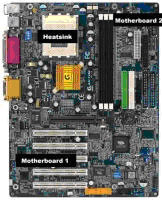SilverStone Nimiz Temjin III
by Purav Sanghani on March 16, 2004 11:04 PM EST- Posted in
- Cases/Cooling/PSUs
Benchmarking
In the past, we have performed heat and sound tests on the cases that we reviewed to show how they perform against others in their class. The fan speeds were all at their normal operating speeds and the power supply fan was turned off. The heat sink temperature is the actual temperature inside the heat sink and the CPU temperature is the actual temperature, both during normal system operation. Take a look at our results.Gigabyte GA-7VRX |
|
The thermal readings for the key components and points on the motherboard during operation were as follows:
| SilverStone SST-TJ03 | ||||||||
| System On-Time | CPU | Heatsink | HDD | DDR | Northbridge | Southbridge | Power Supply | System Ambient |
| 10 | 51.2 | 35.4 | 26.9 | 33.2 | 38.2 | 38.1 | 29.1 | 28.5 |
| 30 | 52.6 | 36.8 | 27.4 | 35.5 | 39.5 | 38.5 | 31.2 | 30.1 |
| Kingwin KT-436-WM | ||||||||
| System On-Time | CPU | Heatsink | HDD | DDR | Northbridge | Southbridge | Power Supply | System Ambient |
| 10 | 54.0 | 38.0 | 27.2 | - | 25.0 | 28.5 | - | - |
| 30 | 54.5 | 38.9 | 27.4 | - | 26.1 | 29.0 | - | - |
| ThermalTake A6000B | ||||||||
| System On-Time | CPU | Heatsink | HDD | DDR | Northbridge | Southbridge | Power Supply | System Ambient |
| 10 | 55.0 | 38.1 | 37.0 | - | 25.3 | 30.2 | - | - |
| 30 | 55.5 | 42.4 | 40.3 | - | 27.4 | 32.1 | - | - |
As we can see, the 120mm intake fan improved airflow through the system, keeping all of the tested components a few degrees cooler than Thermaltake's Xaser III Skull. However, the Kingwin KT-424 still leads the pack. We noticed that the temperature readings we took of the TJ03 were lower than the KT-436 as well as the A6000B for the CPU, heat sink, and hard drive, but much higher for the north and south bridges. This difference in temperatures could have been due to the variation of exposure to the air flow from the 120mm intake fan. Since the Northbridge and Southbridge sit on the motherboard, they may not have been receiving proper ventilation. This could have been improved by adding a fan to the side panel, which would exhaust warm air from those areas; or better, an intake that would blow air directly at those components.
When choosing a case, looks and expandability are not the only factors that determine its quality. Noise levels also contribute to the decision. We tested the Nimiz's noise level about 12" away from the sealed chassis and compared it to other cases in its class that we have previously assessed.
| Case | dBA |
| SilverStone Nimiz Temjin III | 53 |
| Kingwin KT-424 Aluminum | 55 |
| Thermaltake Xaser III Aluminum Fan Low | 52 |
| Cooler Master ATC-201A Aluminum | 53 |
| Kingwin KT-436-BK-WM Aluminum | 50 |
Though not the quietest of our last five aluminum cases, the noise rating of the Nimiz is lower due to the inclusion of the 120mm fan. This large fan produced lower frequencies, which we perceived to be quieter than the small 80mm fans. This phenomenon also occurred with the Ahanix dBox that we reviewed back in January of last year with its 120mm intake.











11 Comments
View All Comments
Zebo - Wednesday, March 17, 2004 - link
Work of art. I have a silverstone desktop case and it's the same. Has hydrolic doors and an awesome matte alum finish. IMO SS's are worth every dime you pay. Finally someone is building high quality/high fashion cases.